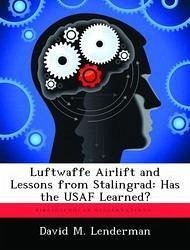World War II brought with it the dawn of moving equipment and personnel by air. For military leaders this new technology provided a faster way of providing supplies to soldiers at the end of long lines of communication. All military operations since WWII have included airlift operations, specifically intra-theater airlift, which plays an important role in the commander's ability to prosecute war. This paper will analyze the impact intra-theater airlift had in WWII, in particular the Stalingrad Airlift operation of the Luftwaffe. The lessons gleaned from studying WWII airlift operations are still valid today. In recent military operations commanders struggled with the lack of intra-theater airlift. The Stalingrad Airlift taught the Germans many costly lessons about integrating logistical planning and executing airlift operations. US military leaders did not necessarily learn these lessons in the planning and execution of Operation Iraqi Freedom. The impact intra-theater airlift will have on future operations will be significant with the transformed Army and Marine Corps focusing on speed and maneuver warfare. The lessons from Operation Iraqi Freedom will be lasting and should shape the future because intra-theater airlift will continue to play an important role in combat operations.








